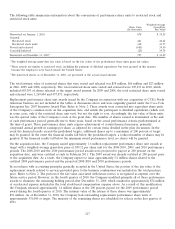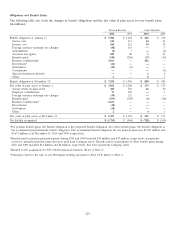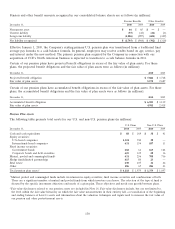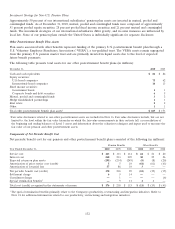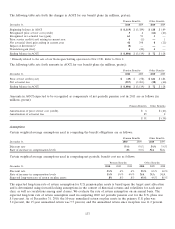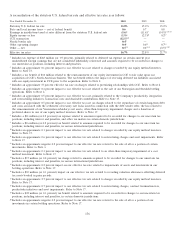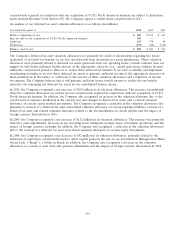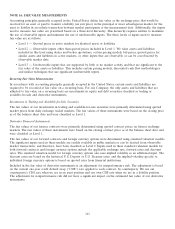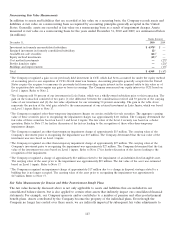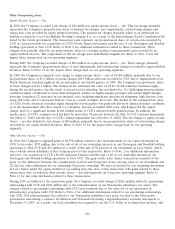Coca Cola 2010 Annual Report Download - page 139
Download and view the complete annual report
Please find page 139 of the 2010 Coca Cola annual report below. You can navigate through the pages in the report by either clicking on the pages listed below, or by using the keyword search tool below to find specific information within the annual report.
Our effective tax rate reflects the tax benefits from having significant operations outside the United States that are
taxed at rates lower than the statutory U.S. rate of 35 percent. In 2010, 2009 and 2008, the Company had several
subsidiaries that benefited from various tax incentive grants. The terms of these grants range from 2010 to 2031. The
Company expects each of the grants to be renewed indefinitely. The grants did not have a material effect on the results
of operations for the years ended December 31, 2010, 2009 or 2008.
The Company or one of its subsidiaries files income tax returns in the U.S. federal jurisdiction and various state and
foreign jurisdictions. U.S. tax authorities have completed their federal income tax examinations for all years prior to
2005. With respect to state and local jurisdictions and countries outside the United States, with limited exceptions, the
Company and its subsidiaries are no longer subject to income tax audits for years before 2002. For U.S. federal and
state tax purposes, the net operating losses and tax credit carryovers acquired in connection with our acquisition of
CCE’s North American business that were generated between the years of 1993 through 2002 and 2004 through 2009
are subject to adjustments, until the year in which they are actually utilized is no longer subject to examination.
Although the outcome of tax audits is always uncertain, the Company believes that adequate amounts of tax, including
interest and penalties, have been provided for any adjustments that are expected to result from those years.
As of December 31, 2010, the gross amount of unrecognized tax benefits was $387 million. If the Company were to
prevail on all uncertain tax positions, the net effect would be a benefit to the Company’s effective tax rate of
$163 million, exclusive of any benefits related to interest and penalties. The remaining $224 million, which was recorded
as a deferred tax asset, primarily represents tax benefits that would be received in different tax jurisdictions in the event
that the Company did not prevail on all uncertain tax positions.
A reconciliation of the changes in the gross balance of unrecognized tax benefit amounts is as follows (in millions):
Year Ended December 31, 2010 2009 2008
Beginning balance of unrecognized tax benefits $ 354 $ 369 $ 643
Increases related to prior period tax positions 26 49 52
Decreases related to prior period tax positions (10) (28) (4)
Increases due to current period tax positions 33 16 47
Decreases related to settlements with taxing authorities —(27) (254)
Reductions as a result of a lapse of the applicable statute of limitations (1) (73) (36)
Increase due to acquisition of CCE’s North American business 6——
Increases (decreases) from effects of exchange rates (21) 48 (79)
Ending balance of unrecognized tax benefits $ 387 $ 354 $ 369
In 2008, agreements were reached between the U.S. government and a foreign government concerning the allocation of
income between the two tax jurisdictions. Pursuant to these agreements, we made cash payments during the third
quarter of 2008 that constituted payments of tax and interest. These payments were partially offset by tax credits taken
in the third quarter and fourth quarter of 2008, and tax refunds and interest on refunds received in 2009. These
benefits had been recorded as deferred tax assets in prior periods. As a result of these agreements, these deferred tax
assets were reclassified to income tax and interest receivables. These settlements did not have a material impact on the
Company’s consolidated financial statements.
The Company recognizes accrued interest and penalties related to unrecognized tax benefits in income tax expense. As
of December 31, 2010, 2009 and 2008, the Company had $112 million, $94 million and $110 million in interest and
penalties related to unrecognized tax benefits accrued, respectively, of which $17 million of expense, $16 million of
benefit and $14 million of benefit was recognized through income tax expense in the years ended December 31, 2010,
2009 and 2008, respectively. If the Company were to prevail on all uncertain tax positions, the reversal of this accrual
would also be a benefit to the Company’s effective tax rate.
It is expected that the amount of unrecognized tax benefits will change in the next twelve months; however, we do not
expect the change to have a significant impact on our consolidated statements of income or consolidated balance sheets.
These changes may be the result of settlement of ongoing audits, statute of limitations expiring, or final settlements in
transfer pricing matters that are the subject of litigation. At this time, an estimate of the range of the reasonably
possible outcomes cannot be made.
137


